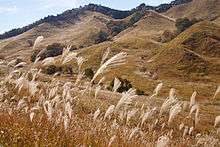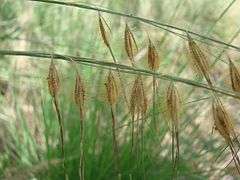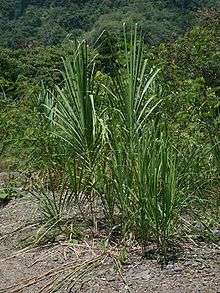Panicoideae
| Panicoideae | |
|---|---|
 | |
| Miscanthus sinensis in Tonomine Highlands, Japan | |
| Scientific classification | |
| Kingdom: | Plantae |
| (unranked): | Angiosperms |
| (unranked): | Monocots |
| (unranked): | Commelinids |
| Order: | Poales |
| Family: | Poaceae |
| (unranked): | PACMAD clade |
| Subfamily: | Panicoideae A. Braun (1864) |
| Tribes | |
|
12 tribes, see text | |
| Synonyms[1] | |
| |
Panicoideae is the second-largest subfamily of the grasses with over 3,500 species, mainly distributed in warm temperate and tropical regions.[1] It comprises some important agricultural crops, including sugarcane, maize (or corn), sorghum, and switchgrass.
C4 photosynthesis evolved independently a number of times in the subfamily, which presumably had a C3 ancestor.[2]
Systematics and taxonomy
Within the PACMAD clade of grasses, the Panicoideae are sister to a clade made of the four subfamilies Arundinoideae, Chloridoideae, Danthonioideae, and Micrairoideae.[2] A modern phylogenetic classification divides the Panicoideae in twelve tribes corresponding to monophyletic clades; two genera, Chandrasekharania and Jansenella, are unplaced (incertae sedis) but probably belong to tribe Tristachyideae.[1] The three largest tribes, Paniceae, Paspaleae, and Andropogoneae, together with the small Arundinelleae, form the core of the subfamily. The Gynerieae were formerly placed in Arundinoideae, and the basal lineage, the "centothecoid clade" with seven tribes, was formerly seen as separate subfamily, Centothecoideae.[1]
Phylogeny based on chloroplast DNA analyses, showing relationships of tribes within the subfamily (dashed lines indicate uncertain positions; C4 clades flagged):[1][2][3][4]
| Panicoideae |
| ||||||||||||||||||||||||||||||||||||||||||||||||||||||||||||||||||||||||
| |
Gallery
- Diversity of Panicoideae
 Woodoats (Chasmanthium latifolium, Chasmanthieae)
Woodoats (Chasmanthium latifolium, Chasmanthieae) Spikelets of Loudetiopsis chrysothrix (Tristachyideae)
Spikelets of Loudetiopsis chrysothrix (Tristachyideae)
 Feathertop grass (Pennisetum villosum, Paniceae)
Feathertop grass (Pennisetum villosum, Paniceae) Cultivated maize or corn (Zea mays, Andropogoneae)
Cultivated maize or corn (Zea mays, Andropogoneae)
References
- 1 2 3 4 5 Soreng, Robert J.; Peterson, Paul M.; Romschenko, Konstantin; Davidse, Gerrit; Zuloaga, Fernando O.; Judziewicz, Emmet J.; Filgueiras, Tarciso S.; Davis, Jerrold I.; Morrone, Osvaldo (2015). "A worldwide phylogenetic classification of the Poaceae (Gramineae)". Journal of Systematics and Evolution. 53 (2): 117–137. doi:10.1111/jse.12150. ISSN 1674-4918.

- 1 2 3 Grass Phylogeny Working Group II (2012). "New grass phylogeny resolves deep evolutionary relationships and discovers C4 origins". New Phytologist. 193 (2): 304–312. doi:10.1111/j.1469-8137.2011.03972.x. ISSN 0028-646X.

- ↑ Morrone, Osvaldo; Aagesen, Lone; Scataglini, Maria A.; Salariato, Diego L.; Denham, Silvia S.; Chemisquy, Maria A.; Sede, Silvana M.; Giussani, Liliana M.; Kellogg, Elizabeth A.; Zuloaga, Fernando O. (2012). "Phylogeny of the Paniceae (Poaceae: Panicoideae): integrating plastid DNA sequences and morphology into a new classification". Cladistics. 28 (4): 333–356. doi:10.1111/j.1096-0031.2011.00384.x. ISSN 0748-3007.
- ↑ Besnard, G.; Christin, P.-A.; Male, P.-J. G.; Coissac, E.; Ralimanana, H.; Vorontsova, M. S. (2013). "Phylogenomics and taxonomy of Lecomtelleae (Poaceae), an isolated panicoid lineage from Madagascar". Annals of Botany. 112 (6): 1057–1066. doi:10.1093/aob/mct174. ISSN 0305-7364.

| Wikimedia Commons has media related to Panicoideae. |
| Wikispecies has information related to: Panicoideae |